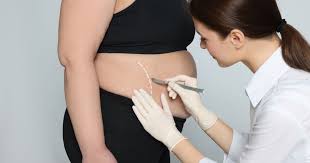If you’re living with diabetes and are considering a Skinny BBL , you may be wondering whether you’re a good candidate for this popular body contouring procedure. After all, diabetes can affect healing, circulation, and immune response — all of which are important factors in any surgical procedure.
So, can someone with diabetes get a Skinny BBL ?
Yes, individuals with diabetes can get a Skinny BBL — but only if their condition is well-managed and they meet specific health requirements set by a certified plastic surgeon.
Let’s explore what you need to know before undergoing a Brazilian Butt Lift for slim women and petite body types , and how to ensure a safe and successful outcome.
Understanding the Impact of Diabetes on Cosmetic Surgery
Diabetes — whether Type 1, Type 2, or gestational — affects how your body regulates blood sugar levels. When blood sugar levels are uncontrolled or unstable , it can lead to poor wound healing, increased infection risk, and complications with tissue recovery .
However, well-managed diabetes — especially with stable blood glucose levels — does not automatically disqualify you from undergoing a Skinny BBL .
Here’s how diabetes can influence your eligibility:
1. Wound Healing
High blood sugar levels can impair circulation and slow the healing process, increasing the risk of infection, delayed healing, or poor scarring .
2. Infection Risk
People with diabetes are more prone to infections due to a weakened immune response , which is a concern after any surgical procedure.
3. Fat Graft Survival
Since a Skinny BBL relies on fat cell survival after transfer, poor circulation or metabolic instability can affect graft retention and final results.
4. Anesthesia and Surgical Risks
Diabetic patients may have higher surgical risks , especially if they have related conditions like hypertension, kidney disease, or neuropathy .
What Makes a Diabetic Patient a Good Candidate?
Before approving a Skinny BBL for someone with diabetes, a certified plastic surgeon will evaluate several key factors to ensure your safety and optimize results.
✅ Stable Blood Sugar Levels
Your HbA1c levels (a 3-month average of your blood sugar control) should be within a safe range , typically below 7% , and preferably closer to 6% for elective surgery.
✅ No Active Diabetic Complications
You should not have active complications such as:
- Diabetic neuropathy (nerve damage)
- Poor circulation (peripheral artery disease)
- Kidney disease
- Retinopathy or vision loss
- Open sores or non-healing wounds
✅ Good Skin Integrity
Your skin should be healthy, elastic, and free of infections or ulcers , especially in the donor and injection areas .
✅ Medical Clearance from a Primary Care Physician
Your surgeon will likely require pre-op clearance from your primary care doctor or endocrinologist to confirm that your diabetes is well-controlled and that you’re healthy enough for surgery.
✅ Commitment to Post-Op Care
Diabetic patients must be especially diligent in following post-operative instructions , including:
- Keeping surgical sites clean and dry
- Monitoring blood sugar levels closely
- Avoiding sitting directly on the buttocks for at least 3–6 weeks
- Attending all follow-up appointments
Preparing for a Skinny BBL with Diabetes
If you’re diabetic and interested in a Skinny BBL , here are the steps you should take to prepare safely:
🩺 1. Get a Full Medical Evaluation
Before surgery, you’ll need:
- Blood work , including HbA1c and fasting glucose levels
- Clearance from your primary care physician or endocrinologist
- A review of your diabetes medications and insulin use
🩸 2. Stabilize Your Blood Sugar
Work closely with your doctor to ensure your blood sugar is well-controlled for at least 3–6 months before surgery.
🍽️ 3. Follow a Healthy Pre-Op Diet
Eat a nutrient-rich, low-sugar diet to support healing and improve surgical outcomes.
🧬 4. Quit Smoking or Nicotine Use
Smoking or vaping can further impair circulation and healing — especially for diabetic patients — and must be avoided for at least 6 weeks before and after surgery .
💊 5. Discuss Medications with Your Surgeon
Some diabetes medications may need to be adjusted or paused before surgery. Always follow your surgeon’s and physician’s guidance on managing your medications.
What to Expect During Recovery
Recovery from a Skinny BBL is similar for diabetic and non-diabetic patients, but extra precautions are necessary:
🕒 Healing Time
- Diabetic patients may experience slightly slower healing , so recovery may take longer than average .
- Full recovery typically takes 6–8 weeks , but some patients may need more time.
👨⚕️ Monitoring for Complications
- You’ll need to be especially vigilant about infection, delayed healing, and wound breakdown .
- Signs of complications include redness, swelling, warmth, drainage, or fever — and should be reported immediately.
🩺 Follow-Up Appointments
- You may need more frequent check-ups to monitor healing and ensure proper recovery.
- Your surgeon may also coordinate care with your primary care provider to ensure your diabetes remains stable.
Final Thoughts
Having diabetes does not automatically rule you out for a Skinny BBL , but it does require careful planning, medical clearance, and strict post-op compliance . With good blood sugar control and a supportive surgical team , many diabetic patients can safely undergo a Skinny BBL and enjoy beautiful, natural-looking enhancement.
The key is to work with a certified plastic surgeon who has experience with diabetic patients and understands the unique considerations involved.
Ready to Take the Next Step?
If you’re a diabetic patient considering a Skinny BBL , start by consulting with a verified provider in major cities like Los Angeles, Miami, Houston, and Dallas .
Our directory connects you directly with board-certified plastic surgeons experienced in the latest body contouring trends , ensuring you receive personalized, high-quality care tailored to slim and petite body types .
With the right preparation and support, you can achieve a naturally enhanced silhouette — safely and confidently.






Leave a Reply